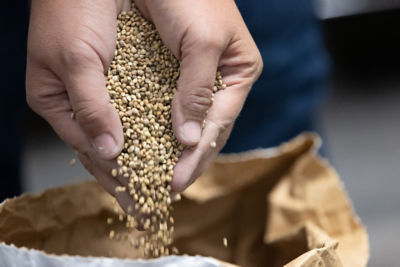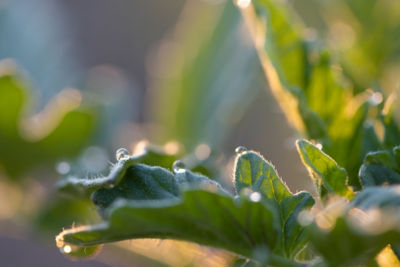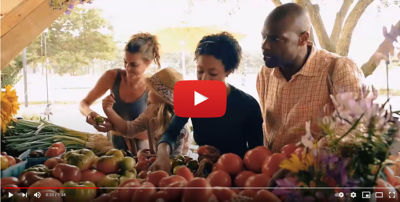Click here to download a PDF version of this spotlight.
» Bacterial leaf streak is a disease of field corn, popcorn, and sweet corn that is new to North America.
» Symptoms of bacterial leaf streak can be confused with other foliar corn diseases.
» The pathogen that causes bacterial leaf streak overwinters on infested corn debris.
The bacterium Xanthomonas vasicola pv vasculorum (syn. X. campestris pv zeae) causes bacterial leaf streak of corn, and the disease has been observed on field corn, seed corn, popcorn, and sweet corn.1,2 The disease was first identified in the United States in Nebraska in 2016, but there is evidence that the disease was present as early 2014. As of 2019, bacterial leaf streak (BLS) has been reported on corn in ten states: Colorado, Illinois, Iowa, Kansas, Minnesota, Nebraska, Oklahoma, South Dakota, Texas, Wisconsin.3 The disease is also known to occur in South Africa, Argentina, and Brazil.
Because the disease is relatively new and has not been studied extensively, the potential effects of the disease on yield are not yet known. The disease damages leaf tissue, and yield losses will probably be directly correlated to the amount of photosynthetic leaf area affected.3
SYMPTOMS
The pathogen can infect corn plants, and symptoms can appear at any stage of plant development. Under field conditions, symptoms have been observed on plants as young as the V4 stage, and symptoms have been observed on seedlings in greenhouse studies.2,3
 Figure 1. Narrow foliar lesions are characteristic symptoms of bacterial leaf streak on sweet corn. Tamra Jackson-Ziems, University of Nebraska.
Figure 1. Narrow foliar lesions are characteristic symptoms of bacterial leaf streak on sweet corn. Tamra Jackson-Ziems, University of Nebraska.
Symptoms of BLS include narrow lesions on the leaves with wavy edges (Figure 1). The lesions initially develop between the veins in the leaf. The affected areas vary in size from small flecks to lesions several inches long, and the color can vary from yellow to orange to tan to brown. The lesions may look water-soaked or greasy.1,2 When leaves are backlit (e.g. held up to the sun) the lesions appear translucent and surrounded by bright yellow halos (Figure 2). With time, the lesions can expand and coalesce, forming large areas of leaf necrosis (Figure 3). Disease severity levels of up to 30% leaf area effected have been documented with BLS.1
 Figure 2. Yellow halos are visible around lesions when leaves are backlit. Tamra Jackson-Ziems, University of Nebraska.
Figure 2. Yellow halos are visible around lesions when leaves are backlit. Tamra Jackson-Ziems, University of Nebraska.
Lesions usually develop first in the lower canopy. However, they can occur in the upper canopy, especially after tasseling.1 Following severe storms or heavy rains, lesions can form in the midto upper-canopy without first appearing on lower leaves. When this happens, the lesions tend to form along the midrib of the leaf (Figure 4).1,2
The symptoms of BLS look somewhat similar and may be confused with symptoms of other foliar diseases of corn, including gray leaf spot, common rust, Diplodia leaf streak, southern corn leaf blight, insect injuries (leaf miner), and genetic and abiotic disorders. Accurate diagnosis of BLS will likely require submitting a sample to a plant disease clinic where the identity of the bacterial pathogen can be verified.1,2
DISEASE CYCLE AND FAVORABLE CONDITIONS
The BLS bacterium most likely overwinters in infested corn debris from a previous year’s crop. This debris serves as a source of inoculum for the current crop. The bacterium spreads from the infested debris to the leaves of living corn plants by splashing water (rain or overhead irrigation). The bacterium also can spread from plant to plant through leaf contact (a healthy leaf rubbing against an infected leaf). Once on the leaves, the pathogen infects through natural openings, such as stomata. Wounding of the leaf is not required for infection. The disease can be spread to other fields on infested corn debris carried on equipment, blown in the wind, or on corn residue brought into a field to feed livestock.2,3
 Figure 3. Lesions enlarge and coalesce resulting in substantial losses of photosynthetic leaf area. Vinicius Garnica, Bugwood.org.
Figure 3. Lesions enlarge and coalesce resulting in substantial losses of photosynthetic leaf area. Vinicius Garnica, Bugwood.org.
Disease spread, infection, and disease development are favored by splashing water, periods of high humidity, and leaf wetness. The disease can be severe following periods of strong storms and heavy rainfall. Because the pathogen overwinters in crop debris, no-till and minimum-till operations that leave corn residue on the soil surface are favorable for disease development. Planting corn continuously in the same field allows the inoculum levels of the pathogen to increase leading to increased disease incidence and severity, and the disease is more common in fields that are under continuous corn production.1,2,3
Greenhouse inoculation studies have shown that the BLS bacterium can also infect several crop and weed host plants including oats, rice, grain sorghum, timothy, johnsongrass, green foxtail, bristly foxtail, shattercane, orchard grass, indiangrass, yellow nutsedge, downy bromec, big bluestem, little bluestem, tall fescue, and western wheatgrass. However, the ability of these hosts to serve as a source of inoculum to infect corn has not been verified under field conditions. So, the role of these hosts in the disease cycle on corn is uncertain.2
MANAGEMENT
Because many aspects of this disease are speculative or unverified at this point, the management recommendations for BLS on corn (including sweet corn) are based on a combination of what is known and best guesses. Field sweet corn hybrids may differ in their susceptibility to BLS, but little or no information on the susceptibility of commercially available sweet corn hybrids to BLS is currently available. Growers should assume that all sweet corn hybrids are susceptible to the disease. Evaluations of the effectiveness of bactericide products for managing bacterial streak are underway. Most of the available bactericide products (mostly copper-based compounds) have not been shown to be effective against BLS in inital studies.1,3
Currently, cultural practices are the most effective means to reduce incidence of this disease from year to year. The best management option at this point is to rotate fields to non-host crops to lower inoculum densities of the BLS pathogen. Volunteer corn plants should be removed during rotation periods, and weed management practices should be used to control the growth of other alternate host plants.2,3 Tillage of infested corn residue into the soil will increase the rate of decomposition and lower inoculum levels more quickly. However, tillage is not feasible or desirable in some situations because of soil conservation concerns.2
 Figure 4. Lesions forming along the midrib are typical symptoms of BLS on leaves in the upper canopy. Tamra Jackson-Ziems, University of Nebraska.
Figure 4. Lesions forming along the midrib are typical symptoms of BLS on leaves in the upper canopy. Tamra Jackson-Ziems, University of Nebraska.
Cultivation and harvest equipment should be cleaned before moving from a field containing BLS infected plants into fields with no history of the disease. Be cautious about bringing in corn residues or baled hay that may contain infested weed plants into the field to feed livestock if the field will be planted to sweet corn in the near future.2,3
SOURCES
1 Robertson, A. Broders, K., French, R., Jackson-Ziems, T., Jardine, D., Korus, K., Lang, J., and Leach, J. 2016. Corn disease management: Bacterial leaf streak. Crop Protection Network CPN-2008.
2 Sivits, S. and Jackson-Ziems, T. 2019. Bacterial leaf streak of corn in Nebraska. Cropwatch, June 27, 2019. https://cropwatch.unl.edu/2019/bacterial-leaf-streak-corn-nebraska.
3 Sivits, S., Hartman, T., and Jackson-Ziems, T. 2018. Bacterial leaf streak disease of corn. University of Nebraska Extension. EC3034.
Websites verified 11-5-2019.
ADDITIONAL INFORMATION
For additional agronomic information, please contact your local seed
representative.
Performance may vary from location to location and from year to year, as local growing, soil and weather conditions may vary. Growers should evaluate data from multiple locations and years whenever possible and should consider the impacts of these conditions on the grower’s fields. The recommendations in this article are based upon information obtained from the cited sources and should be used as a quick reference for information about sweet corn diseases. The content of this article should not be substituted for the professional opinion of a producer, grower, agronomist, pathologist and similar professional dealing with this specific crop.
BAYER GROUP DOES NOT WARRANT THE ACCURACY OF ANY INFORMATION OR TECHNICAL ADVICE PROVIDED HEREIN AND DISCLAIMS ALL LIABILITY FOR ANY CLAIM INVOLVING SUCH INFORMATION OR ADVICE.
9067_SE_S4 Published 12-09-2019
Bayer, Bayer Cross Design, and Seminis® are registered trademarks of Bayer Group. All other trademarks are property of their respective owners. © 2019 Bayer Group. All rights reserved.




